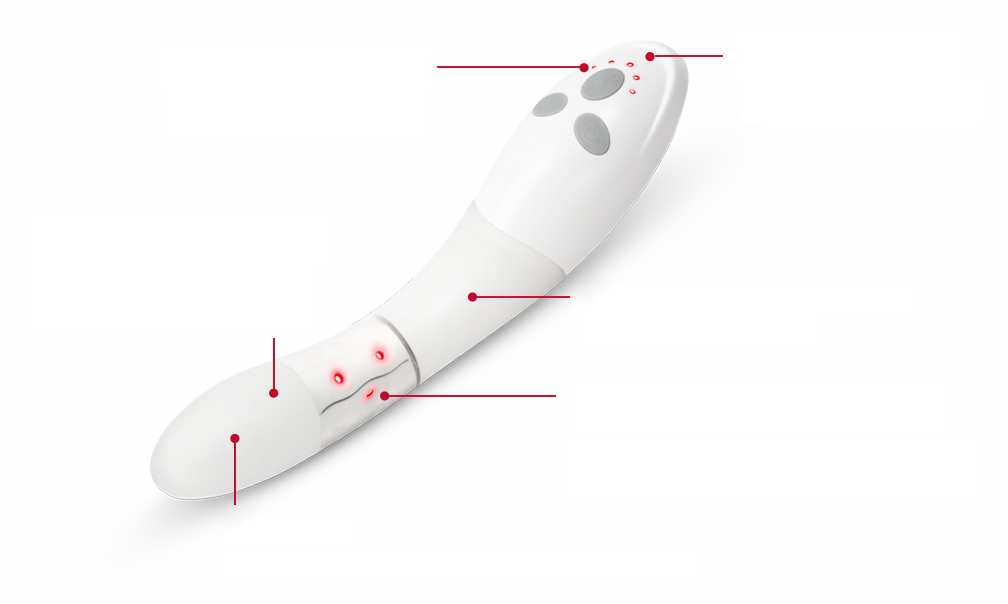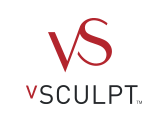You're Not Alone.
Millions of women experience
pelvic floor issues.
Women have turned to vaginal surgery, which is costly and painful, medications that often have significant side effects, or Kegel exercisers that are generally ineffective.
Until now, there were no viable, effective, pain-free, and enjoyable at-home solutions that solved the pelvic floor and vaginal issues experienced by millions of women.
Utilizing a unique blend of therapeutic light, gentle heat, and sonic vibration, vSculpt tones your pelvic floor area.
Our published clinical research study* results show significant improvement in participating women’s pelvic floor muscle strength and quality of life related to incontinence symptoms. Of women participating in a subsequent study*:
90%
Had less bladder leakage
95%
Felt improved vaginal tightness
89%
Experienced an increase in sexual confidence
91%
Had more vaginal hydration
*Results may vary. Study data on file.
Discover vSculpt
Who has time to exercise, let alone do endless Kegels? Just lie back, relax, and enjoy what vSculpt can do for you.
- Quick: Less than 10 minutes per day
- Effective: 9 out of 10 women experience results*
- Safe: Non-surgical, noninvasive, and hormone-free
- Easy: Use in the comfort and privacy of your home
Restore your vaginal tissue and tone your pelvic floor muscles for better bladder control, sensitivity, lubrication, and overall intimate health.
*Results may vary. Study data on file.
Features
3 Light Treatment Modes
Customize your treatmentsTherapeutic Vibration
Improves muscle tone6 modes for customization
Gentle Heat
Helps build collagen and increase circulationTherapeutic Lights
6 red LEDs to restore vaginal tissue and stimulate collagen productionMedical-Grade Materials
Highest grade for safety and comfortNo latex, phthalates, or BPA
USB-Rechargeable
Charging is easy and convenient

What Women Are Saying
Read below to see how vSculpt is empowering women to live their best lives. Results may vary.
VSculpt has helped me alleviate stress incontinence, vaginal pain and dryness. I will definitely continue to use this amazing product. So easy to use! I will continue using vSculpt as it is definitely helping with the pelvic floor muscles. I'm not giving this up!!
You will thank me!
How it Works
vSculpt utilizes an innovative combination of technologies – light therapy, gentle heat, and therapeutic vibration. The result: a stronger, rejuvenated pelvic floor; a reduction in bladder leakage; increased lubrication; a reduction in pelvic muscle pain; and greater self-confidence. Used with our proprietary Photonic Gel, vSculpt's results are enhanced.

Red Light Therapy
- • Energizes cells to increase their natural production of collagen and elastin
- • Helps repair nerve damage and improves muscle tone

Gentle Heat
- • Raises blood flow in the perineal region, which increases delivery of oxygen, proteins, and nutrients to the perineal muscles and tissue for healing

Theraputic vibration
- • Helps tighten the muscles of the pelvic floor to increase muscle tone
- • Allows light energy to more effectively penetrate the tissue

Photonic Gel
- • Ultra-concentrated, water-based gel with hyaluronic acid and aloe
- • Supports the transfer of light into the tissue
- • Helps moisturize and protect tissue
Frequently Asked Questions
See below for answers to your most common questions related to pelvic floor health and vSculpt’s technology and benefits.
- How do I use vSculpt?
- What is the pelvic floor?
- What are the most prevalent pelvic floor issues faced by women?
- What are LEDs?
- How do LEDs differ from lasers?
- What is photobiomodulation?
- How does vSculpt utilize LEDs in its therapy?
- What role does heat play in vSculpt therapy?
- Why does vSculpt use vibration?
- How does vSculpt therapy tone and tighten muscles?
- How does vSculpt therapy help with lubrication?
- How does vSculpt therapy help with sensation?
- How does vSculpt therapy help with tissue regeneration?
- How does vSculpt's Photonic Gel work?
- Has this technology been clinically tested?
- Is vSculpt safe?
- Is vSculpt painful?
- Are online auction and marketplace sites (such as eBay and Groupon) authorized resellers of vSculpt, vSculpt PRO or Photonic Gel?
Q. How do I use vSculpt?
Getting started is easy! First, be sure to charge your vSculpt for at least 24 hours before first use. We recommend you use a clear, water-based gel to help with insertion of the device. Apply a desired amount of gel – a dime-sized amount is a good starting point. (We created our Photonic Gel for use with vSculpt.) Next, turn on your device by pressing the power button. Choose your light mode and press the button to get started. Then lie back, relax, and know you're improving your sexual health.
Q. What is the pelvic floor?
A. The pelvic floor is a hammock-like group of muscles and connective tissue that extends across the base of the pelvis. It provides support for the pelvic organs, the bladder and rectum, and elements of the spine.
Childbearing, menopause, and lifestyle factors (smoking, heavy lifting, chronic constipation, and obesity) can cause weakening of the pelvic floor (hypotonicity), resulting in a host of pelvic floor disorders and/or sexual dysfunction.
Functions of the pelvic floor muscles include:
- Maintaining control of our bladder and bowel
- Enhancing sexual function and pleasure
- Maintaining proper position of the pelvic organs
- Providing lower back support
Q. What are the most prevalent pelvic floor issues faced by women?
A. It has been conservatively estimated that one in three women experiences some form of pelvic floor disorder (PFD) including poor voluntary muscle control, diminished sensation, muscular weakening of the pelvic floor, vaginal laxity, and/or lack of vaginal lubrication. Women who have experienced a vaginal birth or menopause also often complain of urinary incontinence, pain during sex, a loss of vaginal sensation, or decreased pleasure during sexual intercourse. Below are the most common PFDs:
- Bladder leakage or urinary incontinence: Two main urinary incontinence disorders include stress urinary incontinence and urge incontinence (overactive bladder). Stress incontinence results in involuntary loss of urine due to an increase in intra-abdominal pressure such as coughing, sneezing, exercise, or laughing. Urge incontinence occurs when you have a sudden urge to urinate and cannot hold the urine in, causing leakage.
- Vaginitis and pelvic pain: Vaginitis is inflammation of the vagina that can result in discharge, itching, and pain. Pelvic pain, which can be caused by many pelvic disorders, can result in physical, psychological, and emotional distress.
- Female sexual arousal dysfunction (FSAD): FSAD is characterized by persistent, recurrent problems with sexual response, attaining and maintaining sexual arousal, achieving orgasm, or pain.
- Pelvic organ prolapse: Pelvic organ prolapse is the dropping of one or more of the pelvic organs such as the uterus, cervix, bladder, or rectum. These organs may then push against the walls of the vagina, causing a protrusion at or near the vaginal opening that can be uncomfortable and/or cause issues with sexual activity, urination, or bowel function.
- Vaginal dryness: Most common near menopause when hormone levels change, vaginal dryness (atrophy) results when vaginal walls become thinner and inflamed, causing decreased lubrication.
Q. What are LEDs?
A. LED stands for light-emitting diode. When electrically stimulated, LEDs release specific wavelengths (colours) of light. Each colour of light produces unique therapeutic benefits.
Photobiomodulation, also known as low-level light therapy (LLLT), is a noninvasive, painless treatment utilizing LEDs to stimulate cellular function. vSculpt’s red lights are optimized for cellular healing, increased circulation, and reduced inflammation and pain within the vaginal mucosa.
Q. How do LEDs differ from lasers?
A. LEDs (light-emitting diodes) and lasers produce different forms of light for medical therapy. LEDs produce non-coherent light, meaning its light particles (photons) randomly spread out when emitted from a light source. Lasers, on the other other hand, produce coherent light, which means the light particles stay together. Whereas surgical or aesthetic lasers are usually used to cut, burn, coagulate, or otherwise remove tissue, low-level light therapy (LLLT), which utilizes softer, more diffuse light from LEDs, encourages cellular function. Some of these cellular effects can also occur with controlled laser therapy.
vSculpt LEDs encourage muscle, nerve, and connective tissue cells to enhance their functions. This upregulation of cellular function can in turn help with vaginal lubrication, collagen and elastin production, nerve healing, and increased voluntary muscle control. This results in reduced bladder incontinence, increased vaginal lubrication and sensation, and overall toning and tightening of the pelvic floor muscles.
vSculpt is a less invasive, less expensive approach than lasers, and its therapy can be completed in the privacy of a woman’s home. Ask your doctor how vSculpt can complement your in-office treatments.
Q. What is photobiomodulation?
A. vSculpt utilizes photobiomodulation, also known as low-level light therapy (LLLT), which is a noninvasive, painless treatment using light-emitting diodes (LEDs) to stimulate cellular function. Specific LED wavelengths produce photochemical reactions at the cellular level. Treatments can induce physiological reactions with healing benefits, including tissue repair and regeneration, improved nerve function, wound healing, and reduced inflammation or chronic pain.
Q. How does vSculpt utilize LEDs in its therapy?
A. vSculpt utilizes therapeutic LEDs, in addition to gentle heat, and sonic vibration—an innovative combination of technologies—to restore post-pregnancy or menopausal tissue and muscle back to optimal condition. This includes reducing bladder incontinence, increasing vaginal lubrication and sensation, and improving overall toning and tightening of the pelvic floor muscles.
vSculpt utilizes light in the 662nm spectrum, two parts of the normal broad spectrum light profile. These particular wavelengths increase cellular activity and energy levels (ATP) to encourage the cells of muscles, nerves, and connective tissues to upregulate their normal functions. This upregulation of cellular function, in turn, helps with lubrication, collagen and elastin production, nerve healing, and increased voluntary muscle control.
Q. What role does heat play in vSculpt therapy?
A. Heat increases microcirculation, which increases oxygen at the tissue and cellular levels. It also increases nutrients to the muscles and promotes the formation of new blood vessels. Additional blood vessels, oxygen, and nutrients provide the muscles more fuel. Ultimately, this results in enhanced performance of the muscles. Heat, specific to vSculpt, increases the performance and strength of the pelvic floor muscles.
Q. Why does vSculpt use vibration?
A. One of the vital roles of therapeutic vibration involves its positive effect on fibroblasts, participants in the remodeling of the extracellular matrix (ECM), resulting in improved muscle strength of the pelvic floor. In addition to the effects that vibration has on fibroblasts, vSculpt’s vibration provides the benefit of massaging the vaginal tissue, providing a pleasure response in the user. This means the device may be used more frequently and for a longer duration of time, leading to regular and more effective tissue treatments.
Q. How does vSculpt therapy tone and tighten muscles?
A. Each of vSculpt’s modalities—therapeutic LEDs, gentle heat, and sonic vibration—contributes to the strengthening, toning, and tightening of the muscles of the pelvic floor in a specific way:
Low-level light therapy (LLLT) via therapeutic LEDs in the 662nm and 855nm spectrums promotes cellular activity to encourage the cells of muscles, nerves, and connective tissues to up-regulate their functions. This in turn helps with lubrication, collagen and elastin production, nerve healing, and increased voluntary muscle control. Research has shown that the prime receivers of light energy are mitochondria, the control centers of cellular activity.
When LLLT stimulates the mitochondrial factory, increased oxygen and other nutrients are made available to it, allowing for muscle repair and strengthening. Voluntary muscle control is exercised by nerve function. vSculpt enhances the feedback loop in the nerves for maintaining involuntary (baseline) tone to the pelvic floor muscles and provides users better voluntary control over those muscles. The voluntary pelvic floor muscles are a figure eight that surrounds the vaginal, anal, and urethral openings. By strengthening the muscles of the pelvic floor, vSculpt can have a positive impact on bladder control.
Heat increases blood flow, which increases oxygen at the tissue and cellular levels. It also increases nutrients to the muscles and promotes the formation of new blood vessels. Additional blood vessels, oxygen, and nutrients provide the muscles more fuel. Ultimately this results in enhanced performance of the muscles. Heat, specific to vSculpt, increases the performance and strength of the pelvic floor muscles.
Sonic vibration has a positive effect on fibroblasts, participants in the remodeling of the extracellular matrix (ECM), resulting in improved muscle strength of the pelvic floor.
Q. How does vSculpt therapy help with lubrication?
A. With menopause, declining estrogen levels produce changes in a woman’s body that lead to less blood flow and thinning of the vaginal mucosal tissue. This condition, called vaginal atrophy, affects both the vagina and the external female genitalia (vulva). Dry, fragile vaginal tissues are susceptible to injury, tearing, and bleeding. As a result, many postmenopausal women suffer from dryness, irritation, and pain during intercourse. For some women, it can develop into vaginismus, with pain so severe they avoid sex altogether. Vaginal atrophy may be associated with a shorter and narrower vagina, which can result in pain when a woman does have sex, even with the use of a lubricant.
Vaginal lubrication originates from the lamina propria, which contains elastic fibers, blood vessels, lymphatic, and nerves, as well as glands that secrete mucus and serous fluids. Menopause, childbirth, and even certain medications can interrupt the functioning of the lamina propria.
vSculpt helps with lubrication by utilizing photobiomodulation, or low-level light therapy (LLLT), heat, and sonic vibration for cellular repair and regeneration of the lamina propria, which combined with cervical mucus provides lubrication during sex.
Q. How does vSculpt therapy help with sensation?
A. vSculpt utilizes therapeutic LEDs in the 662nm and 855nm spectrums, two parts of the normal broad spectrum light profile. The lights’ properties promote cellular activity to encourage the cells of muscles, nerves, and connective tissue to up-regulate their functions. Among other benefits, this up-regulation of cellular function helps with nerve healing, which can lead to more sensation and more pleasure during sex.
Q. How does vSculpt therapy help with tissue regeneration?
A. vSculpt utilizes photobiomodulation, also known as low-level light therapy (LLLT), during which specific LED wavelengths produce photochemical reactions at the cellular level, specifically with cell membranes, cellular organelles, and enzymes. Brief treatments induce physiological reactions with healing benefits, including tissue repair and regeneration, nerve regeneration, wound healing, reduced inflammation, and less chronic pain.
Q. How does vSculpt's Photonic Gel work?
A. vSculpt’s Photonic Gel was specially designed to advance the therapeutic benefits of vSculpt and contains unique ingredients, including hyaluronic acid. It facilitates the transfer of light energy and allows the therapeutic light to deeply and effectively penetrate the vaginal tissues.
Q. Has this technology been clinically tested?
Yes. The results of our 2016 study of vSculpt with 48 women were published in the peer-reviewed journal, The International Urogynecology Journal. Highlights of our study’s extraordinary results include:
- 90% of participants saw a reduction in bladder leakage
- 82% improved their pelvic floor muscle strength
- 81% saw an improvement in sexual function
Read our full clinical validation report here.
In a second study, Joylux, Inc., owner of vSculpt, engaged The Benchmarking Company to enlist 24 women to test vSculpt. At select intervals throughout the study timeframe, women answered questions regarding instances of urinary incontinence, their state of sexual function, and other differences or improvements. Questions were also asked of participants’ husbands/partners, i.e. whether they noticed changes in the degree of vaginal toning during intercourse.
Female participants who used vSculpt reported the following results, among others:
- 90% had less urinary incontinence
- 95% felt improved vaginal tightness
- 91% no longer experienced uncomfortable vaginal dryness with sex
Q. Is vSculpt safe?
A. Yes. vSculpt utilizes photobiomodulation, also known as low-level light therapy (LLLT), which is a noninvasive, painless treatment utilizing non-coherent light-emitting diodes (LEDs) to stimulate cellular function. Light therapy is used professionally for skincare and rehabilitation in medical clinics and doctors’ offices worldwide.
Joylux partnered with Ondine Biomedical for the design and development of vSculpt. Our team at Ondine comprises experts in the effects of red light in human tissue, including the testing, design, manufacturing, and sales of photodynamic equipment using this modality.
vSculpt follows extreme precautions regarding heat and safety, including an automatic shut-off at 45 degrees Celsius (113 F). Safety tests were completed and validated by a certified testing laboratory.
Q. Is vSculpt painful?
A. No. vSculpt utilizes photobiomodulation, also known as low-level light therapy (LLLT), which is a noninvasive, painless treatment utilizing non-coherent light-emitting diodes (LEDs) to stimulate cellular function. In fact, since one of vSculpt’s modalities is vibration, the device is actually pleasurable to use.
Q. Are online auction and marketplace sites (such as eBay and Groupon) authorized resellers of vSculpt, vSculpt PRO or Photonic Gel?
A. No, online auction and marketplace sites (such as eBay and Groupon) are not authorized retailers of vSculpt, vSculpt PRO or Photonic Gel. If you purchase from an unauthorized institution, our product(s) may be diluted, expired, or counterfeit. They may not be safe to use or perform as tested. Item(s) purchased on online auction and marketplace sites will void the one-year manufacture warranty.
In addition to purchasing on uk.vSculpt.com, visit any of the authorized retailers below to purchase vSculpt:
vSculpt PRO is sold exclusively by the following medical professionals:
Keep in Touch
For discounts, exciting news, and information about new products, subscribe to our newsletter.
Success
Thanks for signing up!
vSculpt Risk-Free Guarantee
We offer a 60-day, 100% money-back guarantee on your vSculpt order. Follow the therapy plan as outlined in the user guide and if you don’t experience results in 60 days or are dissatisfied with your purchase for any reason, please call Customer Care at 1-844-872-8758 to make arrangements for a return.



